|
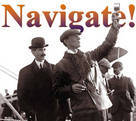
 Up
Up 
 The Birth of
The Birth of
Aviation 
(You are here.)
Past Successes




  Need
to Need
to
find your
bearings?
Try
these
navigation aids:
If this
is your first
visit, please stop by:
Something
to share?
Please:



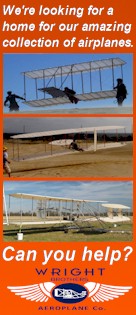 |
|
Available in Française, Español, Português, Deutsch, Россию,
中文,
日本, and others.
 n
2003, the Centennial of Flight, the Wright Brothers Aeroplane
Company unveiled a unique and exciting exhibit at the Dayton Air
Show in Dayton, Ohio. It was the largest display of Wright
airplanes and artifacts ever gathered and the first time that all
the Wright experimental aircraft were shown together. The
exhibition included all of the kites, gliders, and Flyers that
the Wrights built between 1899 and 1905 in the quest for a practical
flying machine. And most important, it told the Wright story by
letting visitors experience it for themselves. n
2003, the Centennial of Flight, the Wright Brothers Aeroplane
Company unveiled a unique and exciting exhibit at the Dayton Air
Show in Dayton, Ohio. It was the largest display of Wright
airplanes and artifacts ever gathered and the first time that all
the Wright experimental aircraft were shown together. The
exhibition included all of the kites, gliders, and Flyers that
the Wrights built between 1899 and 1905 in the quest for a practical
flying machine. And most important, it told the Wright story by
letting visitors experience it for themselves.
Since then, the
"Birth of Aviation" exhibition has been on the road, showing at
science museums, air museums, air shows, and other venues all over
North America. If you're looking for something with a recognizable
name to draw the crowds, something entertaining and educational that
engages and inspires your visitors, something that creates good
experiences and great memories, this exhibit is all of that.
|
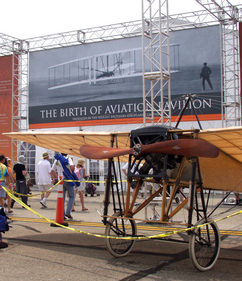
|
The Airplanes
The Birth of Aviation features the most important aircraft in
aviation, the experimental kite, gliders, and airplanes that lead to
the invention of powered flight, making it possible for man to fly.
These include:
- 1899 Wright Kite, with which the Wright brothers tested a
revolutionary idea for controlling an airplane.
- 1900 Wright Glider, the Wrights' first attempt to build a manned
aircraft.
- 1901 Wright Glider, which convinced them of the need for basic
scientific research in aerodynamics.
- 1902 Wright Glider, the first airplane with 3-axis control,
and the basis of the Wright's grandfather
patent.
- 1903 Wright Flyer 1, the first aircraft to make a sustained,
controlled, powered flight.
- 1905 Wright Flyer 3, the first practical aircraft.
These aren't just replicas or static models. They are
operational aircraft. We didn't just build them, we
conducted an expedition in experimental archaeology, test-flying
each aircraft and repeating the flight experiments of the Wright
brothers. In doing so, we gained a deep, personal understanding of
the events that led up to the birth of aviation. This unique
adventure is part of the story we tell.
|
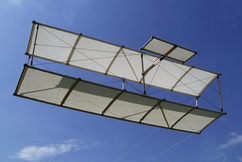
Our 1899 Wright Kite, flown by Nick Engler for the video series "The
Machines of the Wright Brothers."
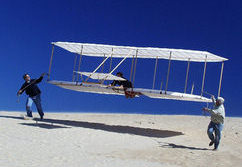
Author James Tobin (left, "To Conquer the Skies") and WBAC members
launch our 1901 Wright Glider for a test flight.
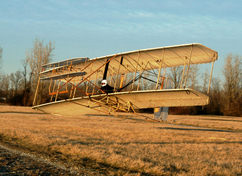
Capt. Connie Tobias repeats the first flight in our 1903 Wright
Flyer.
|
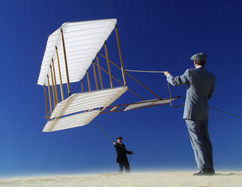
Our 1900 Wright Glider kited by Wright brothers re-enactors Tom
Cherry and Dave Thompson for the documentary "Kitty Hawk: A Journey
of Invention."
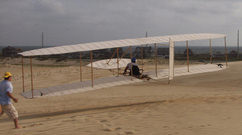
Our 1902 Wright Glider. flown by Capt. Jim Alexander USAF for the
"Centennial of Controlled Flight" in October, 2002.
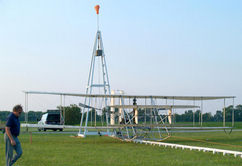
Our 1905 Wright Flyer on the launch rail with the catapult cocked.
|
The Flight Simulators
For each of the gliders and Flyers listed above, we used our
flying experience to develop a corresponding flight
simulator. We partnered with Paul Beardsley, the guru of
virtual pioneer aviation, to develop realistic simulations based
on the writings of the Wright brothers and our own flight data.
As a result, visitors to the Birth of Aviation exhibit can see
and fly all of the Wright brothers' experimental
aircraft, experiencing the frustration and elation of pioneer
flight. In this way, visitors don't just learn about the birth
of aviation. They fly through it. To see our 1903 Wright
Flyer Flight Simulator in action,
CLICK HERE.
|
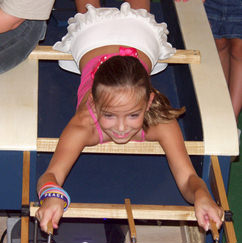
A visitor to the Birth of Aviation Pavillion lands the 1900 Wright
glider on our simulator.
|
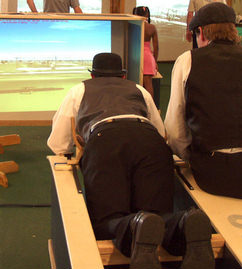
Wright brothers look-alikes flying our 1902 Glider Flight Simulator.
|
The Artifacts
The birth of aviation wasn't all about airplanes and flying. It
incorporated the careful investigation of aerodynamic forces – lift
and drag – both in the laboratory and in real flight. To do this,
the Wright brothers built several scientific instruments and
purchased others. They also combined skills and information from
diverse technologies such as metalworking, woodworking, mechanics,
internal combustion engines, marlinship, sailmaking, and a dozen
more. We have gathered historic artifacts and built displays to show
how the Wrights carefully gathered the materials, abilities, and
knowledge needed to create the first true airplane. These include:
- 1901 Wind tunnel and balances, design the measure
lift and drag of wing shapes and configurations.
- Wright "field" instruments, including a anemometer,
clinometer, stop watch, spring scales, and measuring wheel.
- Wright "Bat," their first flying model.
- An operational letterpress, similar to one owned by
the Wrights, set up to print "The Midget," Orville's first
newspaper, plus examples of their printing skills.
- Wright bicycles, including the "bicycle experiment"
apparatus the Wright's made to test lift forces.
- A working replica of the 1903 Wright engine built by
master machinist Terry Hessler.
- Important pages from the Wrights' scientific diaries
in which they recorded their experiments.
- The actual line-driven drill press used to make the
historic engine.
- A piece of the wing covering of the historic 1903
Wright Flyer.
|
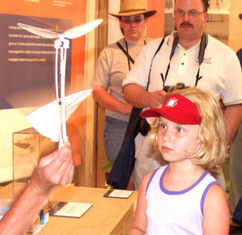
The 1878 Wright "Bat," the very first flying machine made by the
Wright brothers – with their mothers help.
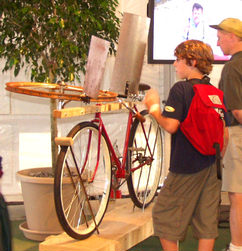
A replica of a Wright "St. Clair" outfitted for an experiment is
aerodynamics.
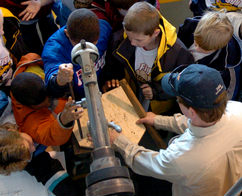
Kids line up to drill a hole with the "Wright" drill press – used to
make the gears for their first airplane engine.
|
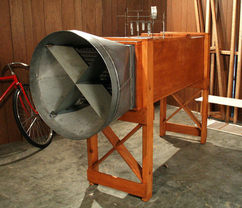
Our replica of the 1901 Wright wind tunnel and the balances used to
measure lift and drag.
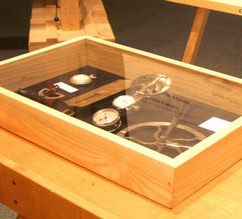
The instruments the Wright brothers used at Kitty Hawk to measure
the performance of their airplanes.
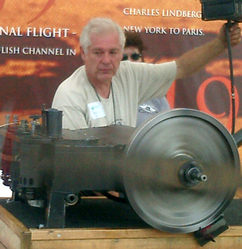
Terry Hessler starts a replica of the 1903 Wright engine.
|
The Videos
The Wright Brothers Aeroplane Company partnered with David
Garrigus Productions to produce "The Machines of the Wright
Brothers," eight short videos that show how the Wrights designed and
built their experimental aircraft, wind tunnel, engine, and
propellers. They are hosted by Wright Brothers Aeroplane Company
director Nick Engler. We play these videos at the appropriate
stations in the exhibition to demonstrate the aircraft and other
equipment for visitors.
|
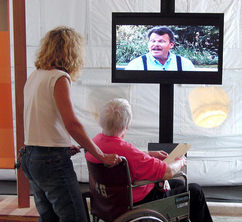
A visitor stops to watch the first segment of "Machines of the
Wright Brothers," which demonstrates the 1899 Wright Kite.
|
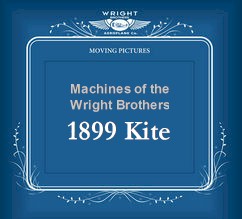
Click the image above to watch "Machines of the Wright Brothers: The
1899 Kite" (3:56).
|
The Timeline
All of these components – aircraft, artifacts, simulators, and
videos – are arranged in a walk-through timeline. Ten-foot high
banners create walls of information and images, explaining how
the Wright brothers attacked and eventually solved the "flight
problem" step by step. Visitors stroll from year to year, seeing how
the Wright brothers evolved and matured. Make no mistake, this is
not just a vaguely interesting collection of old airplanes and
machinery. This is the story of a pivotal historic event and
scientific achievement in in which your visitors can immerse
themselves.
|
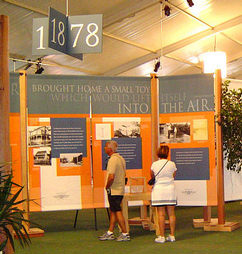
At the beginning of the timeline.
|
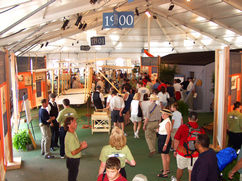
Looking down the timeline from 1900 to 1902 in the Birth of Aviation
Pavilion.
|
The Versatility
The Birth of Aviation exhibit is an integrated assembly of
airplanes, simulators, artifacts, videos, and instructive displays
that all work together to tell a single tale – the story of the
invention of the airplane. However, the exhibit is not rigid.
We designed the components to be adaptable. They can be set up in
many different configurations to best fit the space you have
available.
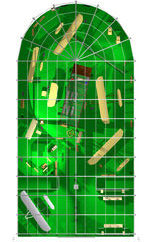 This
is the plan for the Birth of Aviation Pavilion, where we premiered
this exhibit in 2003. If you'd like to experiment with how to fit our airplanes in your facility, we offer a
planning guide we call the "Wright Stuffer."
Download the planning guide by clicking
HERE. This
is the plan for the Birth of Aviation Pavilion, where we premiered
this exhibit in 2003. If you'd like to experiment with how to fit our airplanes in your facility, we offer a
planning guide we call the "Wright Stuffer."
Download the planning guide by clicking
HERE.
|
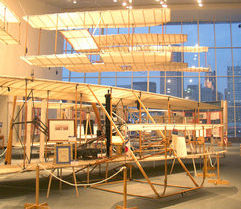
At the Maryland Science Center in Baltimore, we were short on floor
space. So we hung the gliders and the kite.
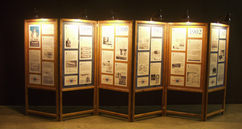
The El Paso Science Museum didn't have the headroom for our 10-foot
banners, so we brought a shorter set.
|
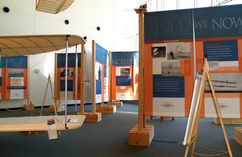
The banners don't have to be arranged to form walls and corridors.
In Omaha, we created "pinwheels." They can also be arranged in
simple squares.
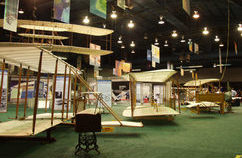
At the Festival of Flight in North Carolina, we sat the gliders on
the floor and hung a Flyer.
|
The Experience
What matters most, of course, has nothing to do with airplanes,
artifacts, simulators, or videos. What matters is what sort of
experience will your visitors will have? To help answer that
question, we asked filmmaker Tom Meyers to visit the Birth of
Aviation Pavilion at the Dayton Air Show in 2005. Tom walked around
and took videos of what he felt were the highlights. It's a short
film, barely four minutes long, but it will show you what to expect.
|
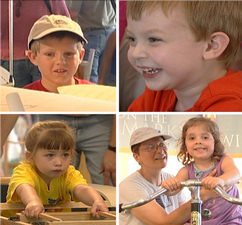
The faces of some of our visitors.
|
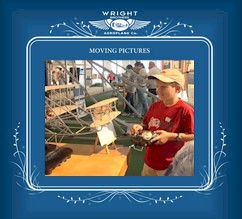
To see some highlights of the Birth of Aviation exhibit, click on
the image above.
|
The Tour
If you have a little more time to spend and you'd like to tour
the Birth of Aviation exhibition and see all of the displays, we can
do that. In this short film (11:05 minutes) Wright Brothers
Aeroplane Company director Nick Engler walks us through the timeline
when we first introduced the exhibition in 2003. It's grown since
then – most important, we've added more simulators – but it gives
you a good idea of the amazing stuff we have to share. |
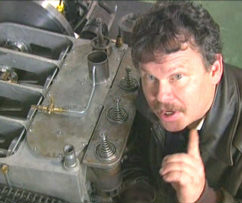
WBAC Director Nick Engler explains the 1903 Wright engine.
|
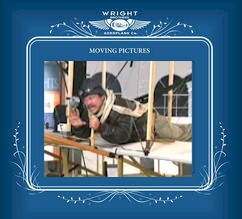
To take a quick tour of the Birth of Aviation exhibit, click on the
image above.
|
|
|
|

